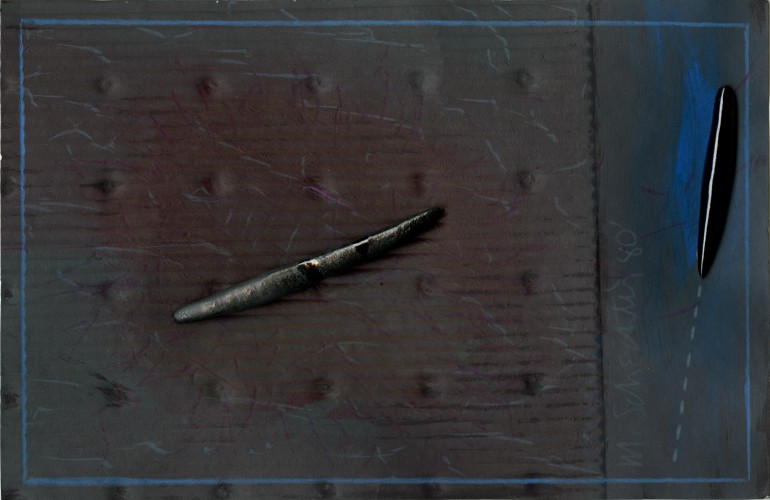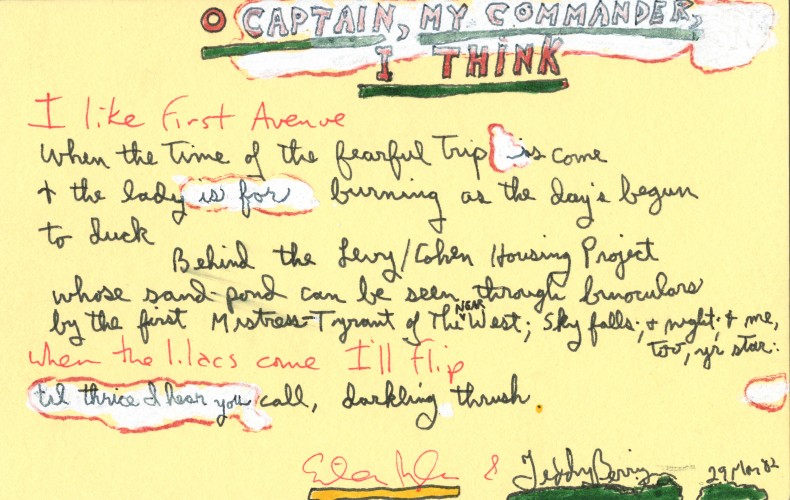What would you do with 500 blank postcards?
For contributors to The Alternative Press, the answers varied. Some hand-wrote poetry on their cards. Some made images--by painting, drawing, collaging, or pasting photographs onto paper. Some embraced the postcard format, while others challenged it--for example, Carol Steen made all of her postcards in brass, a playful take on the form which ensured you could never actually use her cards to mail a message to a friend.
Ken and Ann Mikolowski, who started The Alternative Press in 1969 in the basement of their Detroit home, sent out subscription mailings of letterpress ephemera--broadsides, bookmarks, bumper stickers, and postcards. A few years into the press’s run, they came up with the unique idea to print blank postcards, distribute them to writers and artists, let them do anything they wanted on their cards, and then distribute the results to their subscribers.

Original painting with mystical artifacts, Marilyn Schecter (issue 10, 1980)
These postcards are like little else in literary or art history. Artists and writers had complete freedom on what to make, as long as it fit on a postcard, with no editing or mediation by the press. Subscribers received work by the likes of Jim Gustafson, Anne Waldman, and Ed Sanders, each piece the only one like it in the world. Each card was both a standalone work and a tantalizing glimpse into a larger project; often, considering one artist’s cards as a group reveals common motifs, imagery, or the development of a theme.
Coming up with material to fill 500 blank postcards could be a daunting task. Not everyone who started a postcard set was able to finish. But others were energized by the constraints of the form and the volume of cards. Several people completed more than one set, sometimes competing with each other to finish as many postcards as possible. Faye Kicknosway completed the most: four sets or a staggering two thousand cards.

"O Captain My Commander" original postcard, Ted Berrigan with Eileen Myles (issue 12, 1983)
These projects were often done collaboratively, sometimes by design and sometimes spontaneously. For example, press founder Ken Mikolowski, in looking for ways for artists and writers to collaborate, made a series of postcards with artist Gordon Newton. On the other hand, while Ted Berrigan's set was a solo venture, a visitor to his home might find herself writing a few lines on a postcard-in-progress, as in the postcard shown here with writing by Eileen Myles.
Berrigan later used many of his postcard poems as a basis for his last collection of poetry, A Certain Slant of Light. Several other participants re-published material from their postcard series, but others, like Robert Creeley, purposefully made work that would only ever be seen in postcard form. In these cases, each of the 500 postcards are completely unique, perhaps only seen by a single person. While it would be impossible to reassemble an entire set, The Alternative Press Records includes 10 examples of each.
To see a varied selection of these postcards, and learn more about The Alternative Press, visit the exhibit Free Poems and Functional Art: 50 Years of the Alternative Press, on view in the Hatcher Graduate Library’s Audubon Room through June 2.